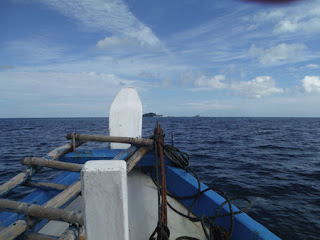Belitung is one of the Bangka/Belitung Islands found east of Sumatra. Bangka and Belitung Islands are the largest in the group of about 400 islands.
Only about 50 islands are inhabited. It is an easy 45 minute flight from home! This island group is located in the Java Sea. Alternate spellings are Belitong and Billiton (English version). The islands were a UK possession from about 1812 until 1824 when the UK transferred the islands to The Netherlands. The name apparently means sea slug. As of the 2014 census, all of Bangka/Belitung had a population of 272,000 with ~ 25,000 or so in the capital of Tangung Pandan.
We were up at 2 am for a 6:45 am flight into Hanadjoedin Airport in Tanjung Pandan. OK, so the easy 45 minute flight required an interesting alarm time. I'll be the first to admit that. Due to weather conditions (aka cloudy with light rain) I didn't get many acceptable photos as we approached the island.
Agriculture.
This is a very small airport! We deplaned and walked a short distance into the Arrival Hall. A few more steps and we were outside of the airport on the other side of the building. We were met by our guide Bu Eksa and our driver Pak Rien and off we went.
It was way too early to try to check in at the hotel so our first stop was a traditional Belitung noodle and kunci orange juice breakfast. Kunci means key. The Belitung noodles were covered with a sweet fish sauce, small tofu, tiny shrimp and carrots. There was also a type of fried cracker on top. It was actually pretty good. By the way, seafood plays a major role in every meal!
Traffic early in the morning in Tanjung Pandan. Yep, pretty much non-existent!
We dropped our carry-on bags at the hotel then we were off to explore the island. First stop was the replica of SD Laskar Pelangi located in Gantong Village. Laskar Pelangi means rainbow troops. An author named Andrea Hirata wrote a novel about a group of 10 students who lived in poverty in Hanging village, Belitung, but this small group of students wished to have better lives. The book was made into a movie. SD Laskar Pelangi was basically a one room school house used for grades one through the equivalent of Junior High School. This replica might have been used in the movie as it was filmed partly in Indonesia. The entire movie (in Bahasa Indonesia without subtitles) is available on YouTube. Search for "Laskar Pelangi." The novel is apparently available in English under the title, "The Rainbow Troops."
Belitung is also known for massive granite boulders. There is even a monument to granite in a traffic circle. Yep, that's a big rock on top!
Certain granites contain tin ore minerals so tin was and is plentiful throughout many of the islands. Belitung Island was heavily mined for tin beginning in the time of the Dutch East Indies. Questionable practices left countless man-made lakes. After being mined out, locations are left as craters filled with acidic subsoil filled with stagnant water. Several global electronics companies support more responsible mining practices and urge miners to make changes. Indonesia is still a major resource for tin. Tin mining continues on other islands and includes offshore mining. The photo below was taken during landing. You can see water filled craters in this photo.
Belitung is now banking on tourism as tin mining is no longer a focus here.
We visited one spot that has been reclaimed and is now a wetlands and recreation spot. These cabanas were really neat.
About 70 km from the airport (on the other side of the island about 20 km from Manggar) we found pretty Pantai Burung Mandi (Bird Bath Beach). It is named for a nearby hill but I didn't get the full explanation of the name. The beach is lined with a lot of casuarina trees and a few coconut trees. The casuarina tree is also called an "Australian Pine." The needles resemble a pine. Interestingly, a few of the other common names for this tree include the word "oak." Hmmm. This plant was imported to the US in the early 1800s but it's suitable only for zones 9-11 and has become a nuisance in Florida. We enjoyed a nice long walk along the beach.
This a not only a pretty beach but also fisherman spot. It appeared that only a couple of the boats had gone out on this day. We could only see a couple of drag marks to the water. The boats are kater wood yachts.The boats have "hands" on the right and left made of bamboo or paralon pipes. These balance the kater while at sea.
The picture above is proof-positive we were really there. :) The receding waters created a wonder of images in the sand. Here's just one! So cool!
We lunched at a cafe in Manggar. We weren't given options for our meals. The food was just delivered to our table*. (* The exception was breakfast eaten at the hotel.) Nearly all of the "no choice " food was really great. Lunch included curried fish, teriyaki fish, fried squid (not my thing), morning glory greens, hot tea and watermelon. And RICE! We lunched right next to a mangrove.
We learned from our driver that Manggar is nicknamed "the city with 1001 coffee shops." We did see a lot of coffee shops and most had a similar name. Example: Bob's Warkopi. Others simply replaced Bob with their own name. Had we felt like coffee at that moment, we could have had coffee at the "best!" place in town.
Our former governor hails from Belitung. There is a small museum across the street from his family home. We stopped only long enough to grab a couple of photos. (The museum shot is ours. The house shot is borrowed.)






































































